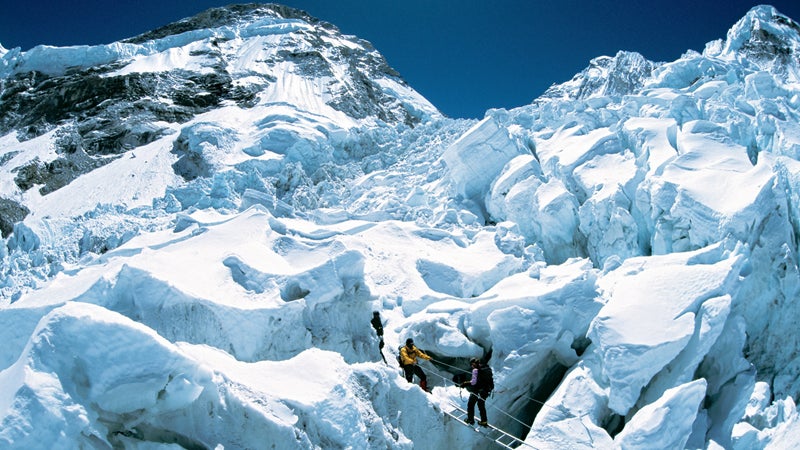May 25, 2003—Karma Sherpa, who for three days had been serving clients at Everest Camp IV, at 26,000 feet, staggered into Camp II suffering from a severe internal organ failure, in dire need of medical assistance. Those who were able to help him did, but radio��pleas to Base Camp for others to come up and assist went unanswered, presumably because most teams were conserving their strength and resources for their upcoming summit attempts. In the constant battle on Everest between personal goals and the direction of your moral compass, all the teams that were contacted elected to stay put.��
Luis Benitez
 Everest summits: 6
Everest summits: 6
Photo: Claudia Lopez
��
So, during a brutal 11-hour rescue attempt that saw one American, two Argentineans, two Italians, and four Sherpas drag the gravely ill man down from Camp II, Karma Sherpa’s heart stopped beating in the middle of the Khumbu Icefall. Another frantic call to base camp went unanswered, and an American, an Argentinean, and a Sherpa knelt side by side and administered CPR, hoping to restart Karma’s heart. He died as the icy walls creaked and groaned around us. When we arrived in base camp later that night, amid the chatter and laughter coming from brightly lit tents, it struck me then, as it does now, what Karma’s death represented: the departure of morality from Everest.
In the beginning of Everest climbing, perhaps all the way back to the 1920’s, Westerners and Europeans were seen as the “Bara Sahibs,” bringing high-paying work to a people who, at the time, were mostly subsistence farmers. The work allowed a very isolated tribe in the Himalayas access to a potentially brighter future. Climbers who felt a special connection to the people and the mountains sought out ways to return and help grow the culture. They brought medicine, education, and higher-order knowledge about how international business was conducted. This was always done with the deepest level of respect and admiration for the community that Western climbers traveled through and worked with. The glory that came from those expeditions was one of shared effort.
If we learn from this crisis, it should no longer be about the bottom line. Morality is a powerful tool when used correctly.
In the commercial era, which began in earnest during the early 90s, expeditions and the climbing culture got more complicated. The Nepali government realized what a cash cow it had with Everest and surrounding peaks, and the older Sherpas were able not only to secure work for family and friends, but, as pay increased, to start sending their children to school both in Kathmandu and abroad. As this generation returned to work on the mountain, we in the guiding community were in a unique position to help advance the culture even more by imparting positive lessons about how we do business during a new, emerging age of wealthy climbing clientele.
Instead, what was the business lesson we consciously or unconsciously chose to impart?
The bottom line, above all else. Maximize profit. Minimize overhead.
Want to advance? Be the strongest. Do double carries to higher camps and get back in time to serve lunch to the Sahibs. If one of you dies? While that is sad, life and our expedition will go on. Bit by bit, this ethos chipped away at a Buddhist culture that is largely based on principles of service and sacrifice.
Now a new generation of Sherpa has the benefit of deeper self-awareness and education. They can speak multiple languages, often have lived abroad, and understand much about how the Western world works. These Sherpas began to ask questions, of themselves and the guiding community.
For the most part, this generation is not willing to remain beholden to Western and European companies for work. They realize that millions have been made by the owners of some foreign guiding companies. They see their resource (Everest) being used for gain, and they have begun to take a stand. Search social media sites, and you will already see Sherpas soliciting clients for future expeditions that will be led and supported by Sherpas. Some companies call these breakaway organizations irresponsible, saying they don’t have enough training to guide Everest trips. Why is that? What have we taught them about business? The bottom line above all else—and they have learned well.
We are at a critical moment in the midst of this crisis. Written in Chinese, the word “crisis” is composed of two characters. One represents danger, the other opportunity. The danger from this event is that, next year, everything will go back to business as usual. This, in my estimation, would signify that those who perished have died in vain, and would be a further scar on the guiding community and an insult to the Sherpa culture.
But this crisis is also an opportunity. I have many friends who are losing a dream this week, because the Everest climbing season may be shut down. These are people who have worked hard, saved money, and will get only one shot at climbing the mountain, given all that was put on hold in their daily lives. Yet their response to this potential loss? Most of them recognize that climbers are guests of the Sherpas, and would support their decision to stop climbing. Two companies I personally worked with for years—Alpine Ascents International and ���ϳԹ��� Consultants—have chosen to cancel their trips at great cost to clients and company. Their message? “We stand with the Sherpas in this time of grieving.” Russel Brice canceled his whole expedition at the very threat of danger in the same place on the mountain in 2012. Bravo.
Now is the time and the opportunity to capture this message and carry it forward. If we learn from this crisis, it should no longer be about the bottom line, or a few companies struggling to change the entire culture, but more about simply doing the right thing. Morality is a powerful tool when used correctly. To truly lead and show the Sherpas that they are not a disposable resource, travel to the Ministry in Kathmandu and lobby beside them for the changes that they seek. Train them how to be better climbers and how to be better at business. Show them that their brothers, fathers, and sons did not die in vain. Will it affect our bottom line? Probably. Will we have more companies to compete with? Absolutely.
Yet here is the ultimate lesson for all of us: It’s the right thing to do.
Luis Benitez (@), a mountain guide who has summited Everest six times, owns Endeavor Consulting, a developmental group that is working with the Everest Alliance in the aftermath of the 2014 avalanche.


